Under the Catchment and Land Protection Act 1994 (CaLP Act) certain plants are declared as noxious weeds in Victoria. These plants cause environmental or economic harm or have the potential to cause such harm. They can also present risks to stock and human health.
The responsibility for enforcing weed control under the CaLP Act lies with Agriculture Victoria within the Department of Jobs, Precincts and Regions.
The CaLP Act defines 4 categories of noxious weeds as detailed below.
State prohibited weeds
They are to be eradicated from Victoria if possible or excluded from the state. The Victorian Government is responsible for their eradication, or can direct landowners to prevent their growth and spread.
Examples: Hawkweed, horsetail, mesquite, Mexican feather grass, parthenium weed, salvinia, water hyacinth
Regionally prohibited weeds
Land owners, including public authorities responsible for crown land management, must take all reasonable steps to eradicate these weeds on their land.
Examples: Cape tulip (one and two leaf), serrated tussock
Regionally controlled weeds
Land owners have the responsibility to take all reasonable steps to prevent the growth and spread of regionally controlled weeds on their land.
Examples: African love grass, Bathurst burr, blackberry, caltrop, gorse, Paterson’s curse, St John’s wort, sweet briar
Restricted weeds
Generally widespread weeds. Trade in these weeds and their propagules (either as plants, seeds or contaminants in other materials) is prohibited.
Examples: Bridal creeper, Chilean needle grass, fennel, stinkwort, soursob, willows
Bridal Creeper
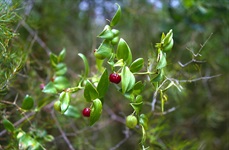 Identification
Identification 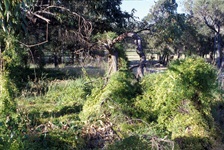
Bridal Creeper (Asparagus asparagoides) is easily identifiable, even during its non-flowering season, by its vine-like habit and leaf shape.
It has light green, almost heart-shaped leaves with pointed ends, white flowers and red pea sized berries.
Except in the wettest areas, it dies off over summer and shoots again in autumn. It has a large underground tuber mass of which any one tuber can grow into a new plant.
Flowering time: August-September
Problem
One of 20 weeds of national significance, Bridal Creeper is considered a serious problem because of its ability to invade undisturbed bushland. Agriculturally it is a particular problem within citrus orchards. It is spread largely by fruit-feeding birds that eat the berries.
Weed management techniques
Herbicide has been used to control Bridal Creeper quite successfully. Always seek professional advice on appropriate herbicides and their use, read and follow instructions given on the product label carefully.
Hand weeding of small infestations in gardens is difficult because of the underground tubers, which can break off in the soil as weeding is occurring. However, if done carefully, and the area is monitored for new plants, it is a successful way of eradication. Due to the tubers ability to re-grow easily, always dispose of carefully through the municipal rubbish collection by enclosing in a thick plastic bag.
Several forms of biological control have been introduced into Australia, including a rust, leafhopper and leaf beetle. These are only suitable for heavily infested areas and require translocation of agents to work.
More information is available on the Weeds Australia - Profiles website.
Horsetails (Equisetum species)
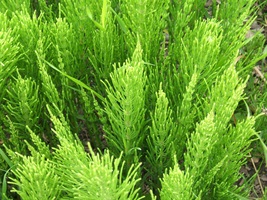
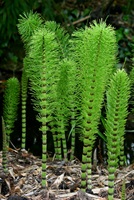 Identification
Identification
Horsetails occur in cold to warm temperate regions with annual rainfall between 100mm and 2000mm. Most species inhabit swampy areas and prefer disturbed sites. There are many species of Horsetail that are potential problems in Australia, they all differ slightly and are hard to identify to a species level.
At the genus level identification is easier, horsetails produce two different shoots. One is sterile, green, hollow and branched and the other is fertile, pale brown, unbranched and produces fruiting cones and dies back to the ground each year. Both kinds of shoots break off easily and feel rough due to the high silica (sand) content within them Problem Horsetails have only been found on a few occasions within Victoria, however, once established they are very difficult to eradicate.
Any suspected or identified horsetail plants should be immediately reported to the State Government. Don’t attempt to control Horsetails on your own.
Visit Agriculture Victoria for more information on how to report Horsetails
Stinkwort
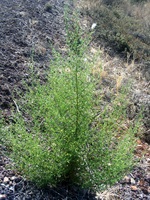
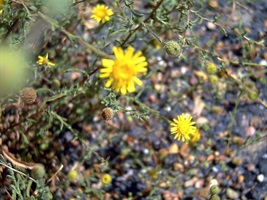 Identification
Identification
Stinkwort (Dittrichia graveolens) can grow to heights of up to one metre.The entire plant is covered in fine white hairs, is sticky and smells very strongly of camphor. Flowers are small and yellow.
Flowering Time: Autumn
Problem
Unlikely to become a serious weed in native bush however it may become invasive within pastures as stock will not preferentially graze it, due to its toxicity. Stinkwort is often a weed of unsealed roadside shoulders. Spread is by seed on the wind or attachment to clothing, machinery or wool.
Weed management techniques
Small infestations can be chipped out prior to seeding or spot sprayed if necessary. If spraying always seek professional advice, read and follow instructions given on the product label carefully.
Note: Some people are allergic to the oil in the plant and may develop severe dermatitis on contact. Gloves should be worn when handling Stinkwort as a precaution.
Sweet Briar
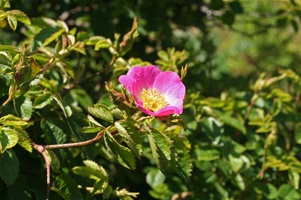
Identification
Sweet Briar (Rosa rubiginosa) is a medium to large shrub that grows up to three metres tall. It is often scrambling, with pink flowers and fruits coloured initially green, then turning yellow before drying to a red or nearly black colour. It has prickly stems and leaves with toothed edges that smell like apples when bruised. Sweet Briar is winter deciduous.
Flowering time: November-January
Problem
Sweet Briar is primarily a problem in disturbed landscapes, such as farmland and roadsides. Heavy infestations can be an impediment to stock and harbour noxious pests such as foxes and rabbits.
Weed management technique
Spray with an approved herbicide or alternatively it can be dug out. If digging plants out then all crown and heavy rootstock must be removed to effectively kill the plant and stop suckering from occurring.
If spraying always seek professional advice, read and follow instructions given on the product label carefully.
Chilean Needle Grass
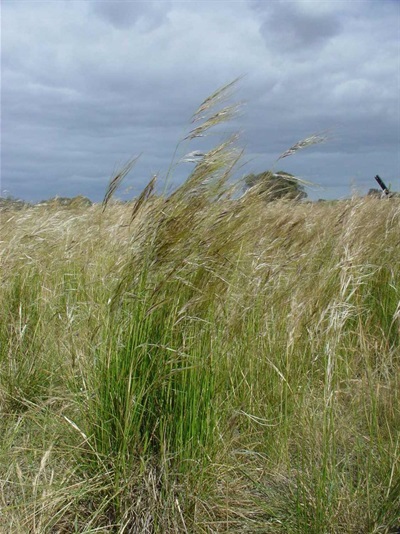
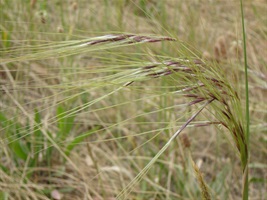 Identification
Identification
Chilean Needle Grass (Nassella neesiana) is a tussock-forming grass, native to South America. Chilean Needle Grass is often mistaken for other grasses such as tall fescue and wallaby grasses, but especially spear grasses. In spring, it produces purple glumes and light green awns that make it easier to identify.
Flowering time
It is easiest to identify Chilean Needle Grass in the spring, when it produces purple glumes and long light green awns.
Problem
Chilean Needle Grass is classified as a Weed of National Significance in Australia. It is highly invasive and is a threat to agricultural, natural and urban environments. In particular, the presence of Chilean needle grass has a devastating impact on agriculture. It can severely reduce pasture productivity and contaminate crops and hay. The needle-like seed can injure animals. Sheep, alpacas and dogs are vulnerable as seeds burrow into their skin and aren’t easy to remove.
Weed management technique
We work closely with our local community Landcare network, Gecko CLaN, on a project to control Chilean Needle Grass through roadside spraying.
If you see Chilean Needle Grass, please call the Customer Service Centre with the location so that we can treat the area.